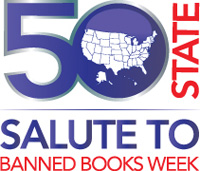 One of the most fiercely guarded—and most fiercely debated—freedoms that citizens of our nation have is the right to read. As long as books are published, there will be titles that offend someone. From talking animals in some fairy tales and folktales to books in which characters explore their sexual identity to titles in which questions about religious beliefs are raised or certain expletives are used, no book can ever be considered safe from offending someone. In honor of the thirtieth anniversary of Banned Books Week—celebrated September 30 to October 6—this week members of the International Reading Association Children’s Literature and Reading Special Interest Group look back at books that have raised the ire of some readers, particularly during the last year. Teachers may be interested in using some of the excellent lessons for different grade levels on examining challenged books at ReadWriteThink.org. The American Library Association also has several useful resources for teachers and librarians and a list entitled Books Challenged or Banned in 2010-2011 compiled by Robert P. Doyle. The ALA websites offer suggestions for how to become involved during Banned Book Week, including writing letters to the editor on behalf of books and reading or rereading a book that has been banned or challenged. Additionally, ALA’s Office for Intellectual Freedom has provided a list of 326 challenges to books during the past year. Among the top ten most challenged books are the ones that appear below.
One of the most fiercely guarded—and most fiercely debated—freedoms that citizens of our nation have is the right to read. As long as books are published, there will be titles that offend someone. From talking animals in some fairy tales and folktales to books in which characters explore their sexual identity to titles in which questions about religious beliefs are raised or certain expletives are used, no book can ever be considered safe from offending someone. In honor of the thirtieth anniversary of Banned Books Week—celebrated September 30 to October 6—this week members of the International Reading Association Children’s Literature and Reading Special Interest Group look back at books that have raised the ire of some readers, particularly during the last year. Teachers may be interested in using some of the excellent lessons for different grade levels on examining challenged books at ReadWriteThink.org. The American Library Association also has several useful resources for teachers and librarians and a list entitled Books Challenged or Banned in 2010-2011 compiled by Robert P. Doyle. The ALA websites offer suggestions for how to become involved during Banned Book Week, including writing letters to the editor on behalf of books and reading or rereading a book that has been banned or challenged. Additionally, ALA’s Office for Intellectual Freedom has provided a list of 326 challenges to books during the past year. Among the top ten most challenged books are the ones that appear below.
GRADES K-3
Butler, Dori Hillestad. (2005). My mom’s having a baby: A month-to-month guide to pregnancy. Illus. by Carol Thompson. Morton Grove, IL: Albert Whitman.
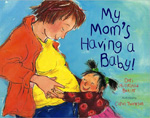 Five-year-old Elizabeth is excited about the arrival of her unborn sibling and is full of questions. Using a nonfiction format, the author has created a month-by-month look at the development of a baby within the mother’s uterus as told by its narrator, Elizabeth, from her childlike perspective. Since older siblings are always curious about a new baby, the book provides accurate and straightforward explanations as to how a baby is conceived and how it grows as a fetus until the baby is ready to be born. The illustrations complement the text in their variety and form from cartoon-like panels to speech balloons or full page spreads. Mother explains how her body is changing to allow for the baby to grow. The love and excitement as well as the anticipation of a new baby brother or sister permeate the book while factual details are woven throughout the months. This book was named a Top Ten Sci-Tech Books for Youth 2005. Teachers can find guides for parents and siblings from the author at her website. Interested readers can listen to the author discuss her book with an adult and a Fox news commentator.
Five-year-old Elizabeth is excited about the arrival of her unborn sibling and is full of questions. Using a nonfiction format, the author has created a month-by-month look at the development of a baby within the mother’s uterus as told by its narrator, Elizabeth, from her childlike perspective. Since older siblings are always curious about a new baby, the book provides accurate and straightforward explanations as to how a baby is conceived and how it grows as a fetus until the baby is ready to be born. The illustrations complement the text in their variety and form from cartoon-like panels to speech balloons or full page spreads. Mother explains how her body is changing to allow for the baby to grow. The love and excitement as well as the anticipation of a new baby brother or sister permeate the book while factual details are woven throughout the months. This book was named a Top Ten Sci-Tech Books for Youth 2005. Teachers can find guides for parents and siblings from the author at her website. Interested readers can listen to the author discuss her book with an adult and a Fox news commentator.
One of the top ten most challenged books reported to the American Library Association’s Office for Intellectual Freedom, the book’s frank and open discussion of how a baby is created disturbed some critics. Many adult readers liked the month-by-month description on the development of the baby and how it grows, but felt uncomfortable with the detailed explanation about conception to a five year old. Arguments swirled around the right age for children or teenagers to learn about the basic facts of “where babies come from.” Many librarians maintained that the book belongs in the nonfiction section of libraries and parents/adults/caregivers have the responsibility of making the choice as to when and if the books will be useful within their family units. On the blog, She Scribes, a lively pro and con discussion of this book reflects the nation-wide controversy can be found. Projects such as The Uprise Book Project state that their goal is to end the cycle of poverty with banned books and proclaim: “We think that parents have a right and an obligation to monitor their own child’s access to literature they feel might be inappropriate, but they can’t control another child’s access. By banning and challenging books in schools and libraries, though, they’re doing exactly that."
- Karen Hildebrand, Ohio Library and Reading Consultant
GRADES 5-8
Harris, Robie H. (2009, 3rd Edition). It’s perfectly normal: A book about changing bodies, growing up, sex and sexual health. Illus. by Michael Emberley. Somerville, MA: Candlewick Press.
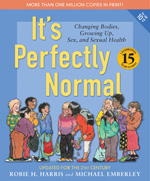 The year 2009 celebrated the 15th anniversary edition of It’s Perfectly Normal. Intended for intermediate and middle school-aged tweens and teens, the book offers answers to the myriad kinds of questions that young people ponder as their bodies change during puberty. The author offers frank and factual information in a straightforward fashion. The introduction, “Lots of Questions,” sets the open tone for the book. Part One launches this format with “What is Sex?” The cartoon-like yet anatomically accurate illustrations serve to lighten the tone and create pictures that can be observed and invite discussion. Throughout the book, his cartoons of the bird and bee discussing the featured topics add a touch of levity to subjects that are often difficult to discuss openly. Other chapters that continue the discussion are: Our Bodies; Puberty; Families and Babies; Decisions; and Staying Healthy. Some of the topics included within these chapters deal with sexual reproduction, sexual desire, sexual intercourse, heterosexuality, homosexuality, sex organs, changing feelings, puberty, birth control, taking care of babies, the cells, sex abuse, STDs, HIV and AIDS, staying healthy, and responsible choices. The most recent edition includes chapters on the Internet and safe use of the Internet and evaluating websites. The publisher has provided an in-depth information sheet on the website that includes notes from the author, talking points for teachers and caregivers using the books with tweens and teens, and comments from doctors and experts in the field of sex education. The author discusses her books on her website. Companion titles from Robie Harris include It’s So Amazing: A Book about Eggs, Sperm, Birth, Babies and Families (2008); It’s NOT the Stork! A Book about Girls, Boys, Babies, Bodies, Families and Friends (2004), and her newest title Who’s in My Family? All about Our Families (2012). The controversy surrounding the book deals with the opinion of some that the book is pornographic. Some critics consider the illustrations too graphic. Other challenges refer to the discussions on intercourse, masturbation, and homosexuality. A school district in the state of Washington removed the book from the school library stating, “The book is an act of encouragement for children to begin desiring sexual gratification…and is a clear example of child pornography.” Challenges have come from schools and public libraries around the country, making this title the American Library Association’s most challenged book in 2005 even though it was supported by such groups as Planned Parenthood. Another type of question surrounding the use of this book is the concern that it is written for children rather than older teens or adults. The ageless argument among parents and adults is the question dealing with age appropriateness as to when the explanation of sex and sexuality should be introduced. (Reference: The American Library Association.)
The year 2009 celebrated the 15th anniversary edition of It’s Perfectly Normal. Intended for intermediate and middle school-aged tweens and teens, the book offers answers to the myriad kinds of questions that young people ponder as their bodies change during puberty. The author offers frank and factual information in a straightforward fashion. The introduction, “Lots of Questions,” sets the open tone for the book. Part One launches this format with “What is Sex?” The cartoon-like yet anatomically accurate illustrations serve to lighten the tone and create pictures that can be observed and invite discussion. Throughout the book, his cartoons of the bird and bee discussing the featured topics add a touch of levity to subjects that are often difficult to discuss openly. Other chapters that continue the discussion are: Our Bodies; Puberty; Families and Babies; Decisions; and Staying Healthy. Some of the topics included within these chapters deal with sexual reproduction, sexual desire, sexual intercourse, heterosexuality, homosexuality, sex organs, changing feelings, puberty, birth control, taking care of babies, the cells, sex abuse, STDs, HIV and AIDS, staying healthy, and responsible choices. The most recent edition includes chapters on the Internet and safe use of the Internet and evaluating websites. The publisher has provided an in-depth information sheet on the website that includes notes from the author, talking points for teachers and caregivers using the books with tweens and teens, and comments from doctors and experts in the field of sex education. The author discusses her books on her website. Companion titles from Robie Harris include It’s So Amazing: A Book about Eggs, Sperm, Birth, Babies and Families (2008); It’s NOT the Stork! A Book about Girls, Boys, Babies, Bodies, Families and Friends (2004), and her newest title Who’s in My Family? All about Our Families (2012). The controversy surrounding the book deals with the opinion of some that the book is pornographic. Some critics consider the illustrations too graphic. Other challenges refer to the discussions on intercourse, masturbation, and homosexuality. A school district in the state of Washington removed the book from the school library stating, “The book is an act of encouragement for children to begin desiring sexual gratification…and is a clear example of child pornography.” Challenges have come from schools and public libraries around the country, making this title the American Library Association’s most challenged book in 2005 even though it was supported by such groups as Planned Parenthood. Another type of question surrounding the use of this book is the concern that it is written for children rather than older teens or adults. The ageless argument among parents and adults is the question dealing with age appropriateness as to when the explanation of sex and sexuality should be introduced. (Reference: The American Library Association.)
- Karen Hildebrand, Ohio Library and Reading Consultant
GRADES 9-12
Alexie, Sherman. (2007). The absolutely true diary of a part-time Indian. Illus. by Ellen Forney. New York: Little, Brown.
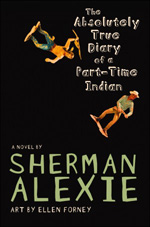 Filled with humor and pathos, this title describes the decision made by Arnold Junior (or Arnold, his white name) to leave the Spokane Indian Reservation for a better education in the nearby town of Reardon. The author’s description of the poverty, alcoholism, and depression that fill the lives of those around Junior make it easy to understand why he chooses to attend school in a place where he is the only Native American. In some cases, just getting to school is a challenge by itself, and once Arnold settles in, of course, he must navigate the confusing high school social order while fending off accusations of betrayal by the friends he left behind. The author describes the beauty of the area of Washington State where Junior lives and dreams of a brighter future. The pages resonate with cultural awareness and respect for the past and for family amid the certainty that Junior must leave what is familiar if he hopes for more than the bleak lives he often sees around him. Few who have read the title can remain untouched by its clear depiction of the inequities in this nation. Despite its popularity and National Book Award, the title has been challenged due by parents due to what they consider to be offensive language, racism, its religious viewpoint, and its sexually explicit nature.
Filled with humor and pathos, this title describes the decision made by Arnold Junior (or Arnold, his white name) to leave the Spokane Indian Reservation for a better education in the nearby town of Reardon. The author’s description of the poverty, alcoholism, and depression that fill the lives of those around Junior make it easy to understand why he chooses to attend school in a place where he is the only Native American. In some cases, just getting to school is a challenge by itself, and once Arnold settles in, of course, he must navigate the confusing high school social order while fending off accusations of betrayal by the friends he left behind. The author describes the beauty of the area of Washington State where Junior lives and dreams of a brighter future. The pages resonate with cultural awareness and respect for the past and for family amid the certainty that Junior must leave what is familiar if he hopes for more than the bleak lives he often sees around him. Few who have read the title can remain untouched by its clear depiction of the inequities in this nation. Despite its popularity and National Book Award, the title has been challenged due by parents due to what they consider to be offensive language, racism, its religious viewpoint, and its sexually explicit nature.
- Barbara A. Ward, Washington State University Pullman
Collins, Suzanne. (2008-2010). The Hunger games trilogy. New York: Scholastic.
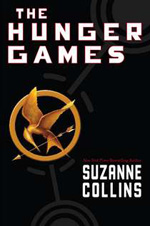 The three books that recently sparked something of a reading craze rivaling that of the Twilight series among teens have come under fire as being anti-family, anti-ethnic, insensitive, violent, and containing offensive language and dealing with the occult or satanic themes. The trilogy centers around Katniss Everdeen, a sixteen-year-old who volunteers to take her younger sister’s place in the annual Hunger Games. Each district selects a male and a female tribute to represent them in a televised fight to the death with only one survivor. Katniss is sure that she stands little chance of surviving, but as it turns out, she has more survival skills than she realized. Sexual tension is provided by her growing attraction to Peeta, the male tribute from her district. The first book is filled with surprises about the post-apocalyptic world in which the story is set, and all three books feature difficult, almost impossible choices about life, death, and survival faced by the book’s characters. At many points, it’s virtually impossible to know who to trust or who to believe. The author weaves a skillful, riveting page-turner that still has many readers thinking about how the series ends.
The three books that recently sparked something of a reading craze rivaling that of the Twilight series among teens have come under fire as being anti-family, anti-ethnic, insensitive, violent, and containing offensive language and dealing with the occult or satanic themes. The trilogy centers around Katniss Everdeen, a sixteen-year-old who volunteers to take her younger sister’s place in the annual Hunger Games. Each district selects a male and a female tribute to represent them in a televised fight to the death with only one survivor. Katniss is sure that she stands little chance of surviving, but as it turns out, she has more survival skills than she realized. Sexual tension is provided by her growing attraction to Peeta, the male tribute from her district. The first book is filled with surprises about the post-apocalyptic world in which the story is set, and all three books feature difficult, almost impossible choices about life, death, and survival faced by the book’s characters. At many points, it’s virtually impossible to know who to trust or who to believe. The author weaves a skillful, riveting page-turner that still has many readers thinking about how the series ends.
- Barbara A. Ward, Washington State University Pullman
Huxley, Aldous. (1946). Brave new world. New York: Harper & Row.
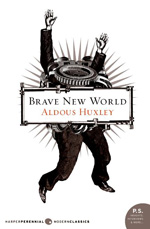 Despite the creation of a perfect society in the world of the future described in this literary classic often read in senior English classes, not everyone is content. One man in particular, Bernard Marx, is bored by the promiscuous, pleasure-seeking aspect of the world in which he lives, and longs to be left alone. Citizens are kept in line through the use of drugs that numb their minds and keep any questions or critical thoughts at bay, and Bernard has grown increasingly uncomfortable with the society he sees around him. For many readers, this early dystopian novel foretold the focus on consumerism that exists today and seems to insist that we buy more, more, more when we really need less, less, less. The book, a perennial title on the list of books that are challenged or banned, earns its place on the list because of insensitivity, nudity, racism, religious viewpoints, and for its sexual explicitness.
Despite the creation of a perfect society in the world of the future described in this literary classic often read in senior English classes, not everyone is content. One man in particular, Bernard Marx, is bored by the promiscuous, pleasure-seeking aspect of the world in which he lives, and longs to be left alone. Citizens are kept in line through the use of drugs that numb their minds and keep any questions or critical thoughts at bay, and Bernard has grown increasingly uncomfortable with the society he sees around him. For many readers, this early dystopian novel foretold the focus on consumerism that exists today and seems to insist that we buy more, more, more when we really need less, less, less. The book, a perennial title on the list of books that are challenged or banned, earns its place on the list because of insensitivity, nudity, racism, religious viewpoints, and for its sexual explicitness.
- Barbara A. Ward, Washington State University Pullman
Hwa, Kim Dong. (2009). The color of Earth series. New York: First Second.
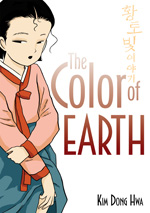 This graphic novel series set in Korea focuses on love, a first love for young Ehwa and a second chance at love for her mother. In the first title, The Color of Earth, Ehwa, the daughter, on the cusp of puberty, is torn between growing affection for a monk-in-training and a wealthy landowner's son while her mother experiences sexual ecstasy with a traveling artist who leaves a brush behind each time he visits. The characters are refreshingly honest about their feelings, and the storyline is engaging and filled with descriptive language that accompanies the softly drawn and painted illustrations whose subtle tints and tones mirror the blush on a young girl’s cheek as she explores the mysteries of her own body. In classic romantic fashion, both females long deeply for love or sexual fulfillment, their feelings a counterpoint against the often vulgar remarks of some of the men in the village and the curiosity of the village children, who are learning about their own bodies in a playful fashion. The relationship between mother and daughter is deep and honest, and no question is too intimate to be asked. The book has been considered too sexually provocative by some and inappropriate for its intended audience.
This graphic novel series set in Korea focuses on love, a first love for young Ehwa and a second chance at love for her mother. In the first title, The Color of Earth, Ehwa, the daughter, on the cusp of puberty, is torn between growing affection for a monk-in-training and a wealthy landowner's son while her mother experiences sexual ecstasy with a traveling artist who leaves a brush behind each time he visits. The characters are refreshingly honest about their feelings, and the storyline is engaging and filled with descriptive language that accompanies the softly drawn and painted illustrations whose subtle tints and tones mirror the blush on a young girl’s cheek as she explores the mysteries of her own body. In classic romantic fashion, both females long deeply for love or sexual fulfillment, their feelings a counterpoint against the often vulgar remarks of some of the men in the village and the curiosity of the village children, who are learning about their own bodies in a playful fashion. The relationship between mother and daughter is deep and honest, and no question is too intimate to be asked. The book has been considered too sexually provocative by some and inappropriate for its intended audience.
- Barbara A. Ward, Washington State University Pullman
Lee, Harper. (1960). To kill a mockingbird. New York: J. P. Lippincott.
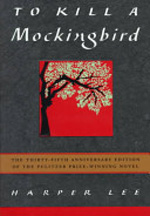 Another ubiquitous title found in the middle and high school literary canon, this book has been challenged frequently for its offensive language and racism. Set in small-town Maycomb, Alabama, in the 1930s, the story centers around the Finch family: Scout, her brother Jem, and their father, Atticus. The storyline involves a mystery or two, a fight for justice, and the unfair laws that existed at the time. Scout must come to her lawyer father’s defense when he defends a black man accused of raping a white girl. She and Jem find it difficult to understand the attitudes of the adults around them when it comes to race and class. In the end, a society heavily mired in decades of prejudice and a double-tiered system of justice is shaken by the words, deeds, and quiet dignity of the heroic Atticus Finch. For many readers, this book represents their coming of age about the topic of social justice and civil rights and has prompted much reflection on the assumptions we make about those around us.
Another ubiquitous title found in the middle and high school literary canon, this book has been challenged frequently for its offensive language and racism. Set in small-town Maycomb, Alabama, in the 1930s, the story centers around the Finch family: Scout, her brother Jem, and their father, Atticus. The storyline involves a mystery or two, a fight for justice, and the unfair laws that existed at the time. Scout must come to her lawyer father’s defense when he defends a black man accused of raping a white girl. She and Jem find it difficult to understand the attitudes of the adults around them when it comes to race and class. In the end, a society heavily mired in decades of prejudice and a double-tiered system of justice is shaken by the words, deeds, and quiet dignity of the heroic Atticus Finch. For many readers, this book represents their coming of age about the topic of social justice and civil rights and has prompted much reflection on the assumptions we make about those around us.
- Barbara A. Ward, Washington State University Pullman
Myracle, Lauren. (2004-2007). Internet girls series. New York: Abrams/Amulet Books.
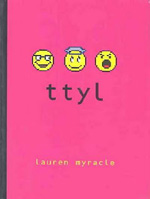 This young adult trilogy is written completely in the style of instant messaging with teen vocabulary. The first title, Ttyl, is internet slang for “talk to you later” and introduces readers to the winsome threesome—Madigan, Zoe, and Angela—who help each other through the ups and downs of high school and young romance. Next in the series are Ttfn “Ta-ta for now” and finally L8r, g8r “Later, gator,” two titles which continue the girls’ friendship as they explore alcohol and drugs and begin sexual relationships. These titles have topped the ALA list of challenged books for offensive language, religious viewpoint, sexually explicit, and unsuited to age group. Myracle is available on Twitter and Facebook to talk to fans about the books, their topics, and her characters.
This young adult trilogy is written completely in the style of instant messaging with teen vocabulary. The first title, Ttyl, is internet slang for “talk to you later” and introduces readers to the winsome threesome—Madigan, Zoe, and Angela—who help each other through the ups and downs of high school and young romance. Next in the series are Ttfn “Ta-ta for now” and finally L8r, g8r “Later, gator,” two titles which continue the girls’ friendship as they explore alcohol and drugs and begin sexual relationships. These titles have topped the ALA list of challenged books for offensive language, religious viewpoint, sexually explicit, and unsuited to age group. Myracle is available on Twitter and Facebook to talk to fans about the books, their topics, and her characters.
- Deanna Day, Washington State University Vancouver
Naylor, Phyllis Reynolds. (1985-2013). Alice series. New York: Simon & Schuster.
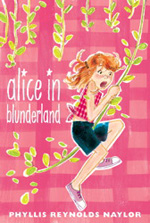 Young girls and women across the world have read one, a couple or all of the books in the Alice series. There are 27 titles that follow the main character, Alice McKinley, from third grade all the way to college. Besides featuring a character to whom readers can easily relate, the books discuss topics such as family, friendship, moving, bullies, prejudice, and body image. When Alice is in high school the books explore themes about identity, first jobs, relationships, dating, and sex. The series has made the ALA most challenged book list for several years for the books’ sexual content. The movie Alice Upside Down is based on the series. In May 2013 the final Alice title, Always Alice, will be published, chronicling Alice’s life from age 18 to 60. Naylor keeps a blog where she answers readers’ questions.
Young girls and women across the world have read one, a couple or all of the books in the Alice series. There are 27 titles that follow the main character, Alice McKinley, from third grade all the way to college. Besides featuring a character to whom readers can easily relate, the books discuss topics such as family, friendship, moving, bullies, prejudice, and body image. When Alice is in high school the books explore themes about identity, first jobs, relationships, dating, and sex. The series has made the ALA most challenged book list for several years for the books’ sexual content. The movie Alice Upside Down is based on the series. In May 2013 the final Alice title, Always Alice, will be published, chronicling Alice’s life from age 18 to 60. Naylor keeps a blog where she answers readers’ questions.
- Deanna Day, Washington State University Vancouver
Sones, Sonya. (2004). One of those hideous books where the mother dies. New York, NY: Simon & Schuster Books for Young Readers.
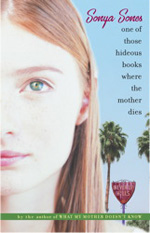 Challenged but then retained at the Theisen Middle School in Fond du Lac, Wisconsin, in 2010 despite a parent’s concern that the book’s “sexual content was too mature for eleven- to fourteen-year-olds,” this title has won several awards, including being named a 2005 Best Book for Young Adults by the American Library Association. A superficial reading of the book might validate the parent’s concern. Explicit references to sex and the desire to have a sexual experience is a chief preoccupation for 16-year-old Ruby Milliken. But that is only a part of who she is and her life experience. As the book opens, Ruby’s mother has just died in Boston, and she is on a plane to start her life with her father she doesn’t know, the famous movie star Whip Logan. Ruby believes that her father doesn’t love her because of what her mother told her about him. Instead, she finds Whip to be a caring and concerned human being and seemingly delighted to have his daughter with him. While Ruby worries about her boyfriend Ray staying faithful to her, she is also drawn to local boy Wyatt. Relying on freestyle prose-poetry, the author paints a vivid picture of pain, teenagers, feminine awareness, and challenges of life in an honest fashion. As the story progresses, Ruby transitions from ignoring her father to accepting him, and even admitting that she is proud to be his daughter. Discovering that he was in a monogamous relationship with another man does not matter to her. She survives both natural and romantic disasters and ultimately realizes that her supposedly uncaring father has kept tabs on her all along.
Challenged but then retained at the Theisen Middle School in Fond du Lac, Wisconsin, in 2010 despite a parent’s concern that the book’s “sexual content was too mature for eleven- to fourteen-year-olds,” this title has won several awards, including being named a 2005 Best Book for Young Adults by the American Library Association. A superficial reading of the book might validate the parent’s concern. Explicit references to sex and the desire to have a sexual experience is a chief preoccupation for 16-year-old Ruby Milliken. But that is only a part of who she is and her life experience. As the book opens, Ruby’s mother has just died in Boston, and she is on a plane to start her life with her father she doesn’t know, the famous movie star Whip Logan. Ruby believes that her father doesn’t love her because of what her mother told her about him. Instead, she finds Whip to be a caring and concerned human being and seemingly delighted to have his daughter with him. While Ruby worries about her boyfriend Ray staying faithful to her, she is also drawn to local boy Wyatt. Relying on freestyle prose-poetry, the author paints a vivid picture of pain, teenagers, feminine awareness, and challenges of life in an honest fashion. As the story progresses, Ruby transitions from ignoring her father to accepting him, and even admitting that she is proud to be his daughter. Discovering that he was in a monogamous relationship with another man does not matter to her. She survives both natural and romantic disasters and ultimately realizes that her supposedly uncaring father has kept tabs on her all along.
- Rani Iyer, Washington State University Pullman